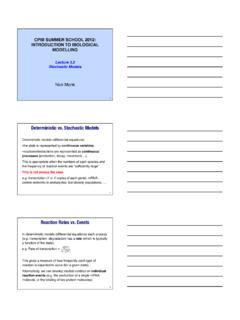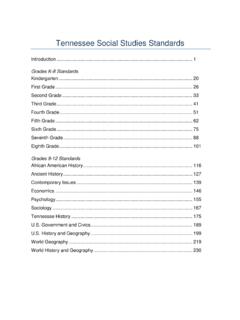Transcription of arXiv:1901.02860v3 [cs.LG] 2 Jun 2019
1 Transformer-XL: Attentive Language ModelsBeyond a Fixed-Length ContextZihang Dai 12, Zhilin Yang 12, Yiming Yang1, Jaime Carbonell1,Quoc V. Le2, Ruslan Salakhutdinov11 Carnegie Mellon University,2 Google have a potential of learninglonger-term dependency, but are limited by afixed-length context in the setting of propose a novel neural ar-chitectureTransformer-XLthat enables learn-ing dependency beyond a fixed length with-out disrupting temporal coherence. It con-sists of a segment-level recurrence mechanismand a novel positional encoding scheme. Ourmethod not only enables capturing longer-termdependency, but also resolves the context frag-mentation problem. As a result, Transformer-XL learns dependency that is 80% longer thanRNNs and 450% longer than vanilla Trans-formers, achieves better performance on bothshort and long sequences, and is up to 1,800+times faster than vanilla Transformers duringevaluation.
2 Notably, we improve the state-of-the-art results of bpc/perplexity to on en-wiki8, on text8, on WikiText-103, on One Billion Word, and on PennTreebank (without finetuning). When trainedonly on WikiText-103, Transformer-XL man-ages to generate reasonably coherent, noveltext articles with thousands of tokens. Ourcode, pretrained models, and hyperparametersare available in both Tensorflow and IntroductionLanguage modeling is among the important prob-lems that require modeling long-term dependency,with successful applications such as unsupervisedpretraining (Dai and Le, 2015; Peters et al., 2018;Radford et al., 2018; Devlin et al., 2018). How-ever, it has been a challenge to equip neuralnetworks with the capability to model long-termdependency in sequential data.
3 Recurrent neu-ral networks (RNNs), in particular Long Short- Equal contribution. Order determined by swapping theone in Yang et al. (2017).1 Memory (LSTM) networks (Hochreiter andSchmidhuber, 1997), have been a standard solu-tion to language modeling and obtained strongresults on multiple thewide adaption, RNNs are difficult to optimizedue to gradient vanishing and explosion (Hochre-iter et al., 2001), and the introduction of gat-ing in LSTMs and the gradient clipping tech-nique (Graves, 2013) might not be sufficient tofully address this , previouswork has found that LSTM language models use200 context words on average (Khandelwal et al.,2018), indicating room for further the other hand, the direct connections be-tween long-distance word pairs baked in atten-tion mechanisms might ease optimization and en-able the learning of long-term dependency (Bah-danau et al.)
4 , 2014; Vaswani et al., 2017). Re-cently, Al-Rfou et al. (2018) designed a set of aux-iliary losses to train deep Transformer networksfor character-level language modeling, which out-perform LSTMs by a large margin. Despite thesuccess, the LM training in Al-Rfou et al. (2018)is performed on separated fixed-length segmentsof a few hundred characters, without any informa-tion flow across segments. As a consequence ofthe fixed context length, the model cannot captureany longer-term dependency beyond the prede-fined context length. In addition, the fixed-lengthsegments are created by selecting a consecutivechunk of symbols without respecting the sentenceor any other semantic boundary. Hence, the modellacks necessary contextual information needed towell predict the first few symbols, leading to inef-ficient optimization and inferior performance.
5 Werefer to this problem ascontext address the aforementioned limitations offixed-length contexts, we propose a new architec-ture called Transformer-XL (meaning extra long).We introduce the notion of recurrence into [ ] 2 Jun 2019deep self-attention network. In particular, insteadof computing the hidden states from scratch foreach new segment, we reuse the hidden states ob-tained in previous segments. The reused hiddenstates serve as memory for the current segment,which builds up a recurrent connection betweenthe segments. As a result, modeling very long-term dependency becomes possible because in-formation can be propagated through the recur-rent connections. Meanwhile, passing informa-tion from the previous segment can also resolvethe problem of context fragmentation.
6 More im-portantly, we show the necessity of using relativepositional encodings rather than absolute ones, inorder to enable state reuse without causing tem-poral confusion. Hence, as an additional techni-cal contribution, we introduce a simple but moreeffective relative positional encoding formulationthat generalizes to attention lengths longer than theone observed during obtained strong results on fivedatasets, varying from word-level to character-level language modeling. Transformer-XL is alsoable to generate relatively coherent long text arti-cles withthousands oftokens (see Appendix E),trained on only 100M main technical contributions include intro-ducing the notion of recurrence in a purely self-attentive model and deriving a novel positional en-coding scheme.
7 These two techniques form a com-plete set of solutions, as any one of them alonedoes not address the issue of fixed-length con-texts. Transformer-XL is the first self-attentionmodel that achieves substantially better resultsthan RNNs on both character-level and word-levellanguage Related WorkIn the last few years, the field of language mod-eling has witnessed many significant advances,including but not limited to devising novel ar-chitectures to better encode the context (Bengioet al., 2003; Mikolov et al., 2010; Merity et al.,2016; Al-Rfou et al., 2018), improving regulariza-tion and optimization algorithms (Gal and Ghahra-mani, 2016) , speeding up the Softmax computa-tion (Grave et al.)
8 , 2016a) , and enriching the outputdistribution family (Yang et al., 2017).To capture the long-range context in languagemodeling, a line of work directly feeds a repre-sentation of the wider context into the networkas an additional works rangefrom ones where context representations are man-ually defined (Mikolov and Zweig, 2012; Ji et al.,2015; Wang and Cho, 2015) to others that rely ondocument-level topics learned from data (Dienget al., 2016; Wang et al., 2017).More broadly, in generic sequence modeling,how to capture long-term dependency has been along-standing research problem. From this per-spective, since the ubiquitous adaption of LSTM,many efforts have been spent on relieving thevanishing gradient problem, including better ini-tialization (Le et al.
9 , 2015), additional loss sig-nal (Trinh et al., 2018), augmented memory struc-ture (Ke et al., 2018) and others that modify the in-ternal architecture of RNNs to ease the optimiza-tion (Wu et al., 2016; Li et al., 2018). Differentfrom them, our work is based on the Transformerarchitecture and shows that language modeling asa real-world task benefits from the ability to learnlonger-term ModelGiven a corpus of tokensx= (x1,..,xT), thetask of language modeling is to estimate the jointprobabilityP(x), which is often auto-regressivelyfactorized asP(x) = tP(xt|x<t). With thefactorization, the problem reduces to estimatingeach conditional factor. In this work, we stick tothe standard neural approach to modeling the con-ditional probability.
10 Specifically, a trainable neu-ral network is used to encode the contextx<tintoa fixed size hidden state, which is multiplied withthe word embeddings to obtain the logits. The log-its are then fed into the Softmax function, yieldinga categorical probability distribution over the Vanilla Transformer Language ModelsIn order to apply Transformer or self-attention tolanguage modeling, the central problem is how totrain a Transformer to effectively encode an arbi-trarily long context into a fixed size infinite memory and computation, a sim-ple solution would be to process the entire con-text sequence using an unconditional Transformerdecoder, similar to a feed-forward neural , this is usually infeasible with the limitedresource in feasible but crude approximation is to splitthe entire corpus into shorter segments of man-Segment 1x1x2x4x3 Segment 2x8x5x6x7(a)
![arXiv:1301.3781v3 [cs.CL] 7 Sep 2013](/cache/preview/4/d/5/0/4/3/4/0/thumb-4d504340120163c0bdf3f4678d8d217f.jpg)
![arXiv:0706.3639v1 [cs.AI] 25 Jun 2007](/cache/preview/4/1/3/9/3/1/4/b/thumb-4139314b93ef86b7b4c2d05ebcc88e46.jpg)

![@google.com arXiv:1609.03499v2 [cs.SD] 19 Sep 2016](/cache/preview/c/3/4/9/4/6/9/b/thumb-c349469b499107d21e221f2ac908f8b2.jpg)














